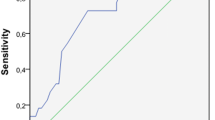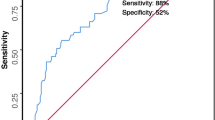Abstract
Purpose
There is no established system for predicting prognosis and evaluating the efficacy of antiseptic treatments such as polymyxin B-immobilized fiber (PMX) according to the severity of peritonitis in patients with colonic perforation. We investigated the predictive value of various severity scoring systems for survival and for the efficacy of antiseptic treatments, to identify high-risk patients.
Methods
We reviewed 26 consecutive patients who underwent emergency operations between 1996 and 2003 for colorectal perforation not caused by trauma or iatrogenic disease. Several severity scores, i.e., Acute Physiology and Chronic Health Evaluation II (APACHE II), Sequential Organ Failure Assessment (SOFA), Mannheim Peritonitis Index (MPI), and Multiple Organ Failure (MOF) were calculated and analyzed as predictive scoring systems for prognosis, survival and efficacy of PMX treatment.
Results
An APACHE II score of 19, a SOFA score of 8, an MPI score of 30, and an MOF score of 7 or more were significantly related to a poor prognosis. With or without PMX treatment, an APACHE II score of 15 or less, a SOFA score of 7 or less, an MPI score of 27 or less, and an MOF score of 7 or less were all related to a good prognosis. Conversely, all patients died when the severity scoring points were higher than 20 in APACHE II, higher than 12 in SOFA, and higher than 39 in MPI. When PMX treatment was given to patients with an intermediate score, no correlation between survival and its efficacy was found, except in the MOF scoring system.
Conclusion
These severity scoring systems can assist with the prediction of prognosis. They may also be useful for determining if PMX treatment would be unnecessary or ineffective in certain patients. However, the optimal application of PMX treatment in selected patients according to the severity scoring systems needs further investigation.
Similar content being viewed by others
References
JL Vincent Q Sun MJ Dubois (2002) ArticleTitleClinical trials of immunomodulatory therapies in severe sepsis and septic shock Clin Infect Dis 34 1084–93 Occurrence Handle11914997 Occurrence Handle1:CAS:528:DC%2BD38XjsFyjurk%3D Occurrence Handle10.1086/339549
S Krivanek C Armbruster K Dittrich P Beckerhinn (1996) ArticleTitlePerforated colorectal cancer Dis Colon Rectum 39 1409–14 Occurrence Handle10.1007/BF02054530
A Nespoli C Ravizzini M Trivella M Segala (1993) ArticleTitleThe choice of surgical procedure for peritonitis due to colonic perforation Arch Surg 128 814–8 Occurrence Handle8317964 Occurrence Handle1:STN:280:DyaK3szgsFSjuw%3D%3D
H Shinkawa H Yasuhara S Naka H Yanagie T Nojiri Y Furuya et al. (2003) ArticleTitleFactors affecting the early mortality of patients with nontraumatic colorectal perforation Surg Today 33 13–7 Occurrence Handle12560901 Occurrence Handle10.1007/s005950300002
R Bone C Fisher T Clemmer G Slotman C Metz R Balk (1989) ArticleTitleSepsis syndrome: A valid clinical entity Crit Care Med 17 389–93 Occurrence Handle2651003 Occurrence Handle1:STN:280:DyaL1M3gvF2isw%3D%3D Occurrence Handle10.1097/00003246-198905000-00002
K Hanasawa T Tani M Kodama (1989) ArticleTitleNew approach to endotoxic and septic shock by means of polymyxin B immobilized fiber Surg Gynecol Obstet 168 323–31 Occurrence Handle2538938 Occurrence Handle1:CAS:528:DyaL1MXitVGisb8%3D
T Tani K Hanasawa M Kodama H Imaizumi M Yonekawa M Saito et al. (2001) ArticleTitleCorrelation between plasma endotoxin, plasma cytokines, and plasminogen activator inhibitor-1 activities in septic patients World J Surg 25 660–8 Occurrence Handle11396436 Occurrence Handle1:STN:280:DC%2BD3MzivVeisA%3D%3D Occurrence Handle10.1007/s002680020028
H Aoki M Kodama T Tani K Hanasawa (1994) ArticleTitleTreatment of sepsis by extracorporeal elimination of endotoxin using polymyxin B-immobilized fiber Am J Surg 167 412–7 Occurrence Handle8179086 Occurrence Handle1:STN:280:DyaK2c3jsVCnuw%3D%3D Occurrence Handle10.1016/0002-9610(94)90126-0
T Sato H Shoji N Koga (2003) ArticleTitleEndotoxin adsorption by polymyxin B immobilized fiber column in patients with systemic inflammatory response syndrome: the Japanese experience Ther Apher Dial 7 252–8 Occurrence Handle12918952 Occurrence Handle10.1046/j.1526-0968.2003.00006.x
Y Asanuma T Furuya J Tanaka T Sato S Shibata K Koyama (1999) ArticleTitleThe application of immobilized polymyxin B fiber in the treatment of septic shock associated with severe acute pancreatitis: report of two cases Surg Today 29 1177–82 Occurrence Handle10552338 Occurrence Handle1:STN:280:DC%2BD3c%2FhvFyksQ%3D%3D
C Hall N Dorricott I Donovan J Neoptolemos (1991) ArticleTitleColon perforation during colonoscopy: surgical versus conservative management Br J Surg 78 542–4 Occurrence Handle2059801 Occurrence Handle1:STN:280:DyaK3M3otlyhtw%3D%3D
EJ Hinchey PG Schaal GK Richards (1978) ArticleTitleTreatment of perforated diverticular disease of the colon Adv Surg 12 85–109 Occurrence Handle735943 Occurrence Handle1:STN:280:DyaE1M7gtVygtw%3D%3D
WA Knaus EA Draper DP Wagner JE Zimmerman (1985) ArticleTitleAPACHE II: a severity of disease classification system Crit Care Med 13 818–29 Occurrence Handle3928249 Occurrence Handle1:STN:280:DyaL2M3otlyqtQ%3D%3D
JL Vincent A de Mendonca F Cantraine R Moreno J Takala PM Suter et al. (1998) ArticleTitleUse of the SOFA score to assess the incidence of organ dysfunction/failure in intensive care units: results of a multicenter, prospective study Crit Care Med 26 1793–800 Occurrence Handle9824069 Occurrence Handle1:STN:280:DyaK1M%2FjvFKktw%3D%3D
S Kriwanek C Armbruster P Beckerhinn K Dittrich (1994) ArticleTitlePrognostic factors for survival in colonic perforation Int J Colorect Dis 9 158–62 Occurrence Handle1:STN:280:DyaK2M7hsVGhsw%3D%3D Occurrence Handle10.1007/BF00290194
MM Linder H Wacha U Feldmann G Wesch RA Streifensand E Gundlach (1987) ArticleTitleThe Mannheim peritonitis index. An instrument for the intraoperative prognosis of peritonitis Chirurg 58 84–92 Occurrence Handle3568820 Occurrence Handle1:STN:280:DyaL2s7ovFeiug%3D%3D
RJR Goris TPA te Boekhorst JKS Nuytinck JSF Gimbrere (1985) ArticleTitleMultiple-organ failure: generalized autodestructive inflammation? Arch Surg 120 1109–15 Occurrence Handle4038052 Occurrence Handle1:STN:280:DyaL2Mzgs1ejuw%3D%3D
Author information
Authors and Affiliations
Additional information
This study was presented at the 104th Annual Congress of the Japan Surgical Society, Osaka, Japan, April 7–9, 2004.
Rights and permissions
About this article
Cite this article
Komatsu, S., Shimomatsuya, T., Nakajima, M. et al. Severity Scoring Systems for Prognosis and Efficacy of Polymyxin B-Immobilized Fiber Treatment for Colonic Perforation. Surg Today 36, 807–810 (2006). https://doi.org/10.1007/s00595-006-3256-z
Received:
Accepted:
Issue Date:
DOI: https://doi.org/10.1007/s00595-006-3256-z




